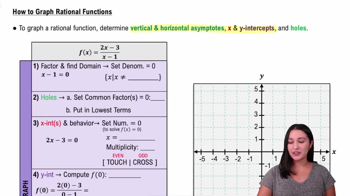Here are the essential concepts you must grasp in order to answer the question correctly.
Rational Functions
A rational function is a function represented by the ratio of two polynomials. The general form is f(x) = P(x)/Q(x), where P and Q are polynomials. Understanding the behavior of rational functions, especially their asymptotic behavior, is crucial for analyzing their graphs.
Recommended video:
Intro to Rational Functions
Slant Asymptotes
A slant (or oblique) asymptote occurs when the degree of the numerator is exactly one higher than the degree of the denominator in a rational function. To find the slant asymptote, perform polynomial long division on the function. The quotient (ignoring the remainder) gives the equation of the slant asymptote, which describes the end behavior of the graph.
Recommended video:
Introduction to Asymptotes
Graphing Rational Functions
Graphing rational functions involves identifying key features such as intercepts, asymptotes, and behavior at infinity. The seven-step strategy typically includes finding intercepts, determining vertical and horizontal/slant asymptotes, and analyzing the function's behavior in different intervals. This comprehensive approach helps create an accurate graph of the function.
Recommended video:
How to Graph Rational Functions
 Verified step by step guidance
Verified step by step guidance Verified video answer for a similar problem:
Verified video answer for a similar problem:



 5:31m
5:31m